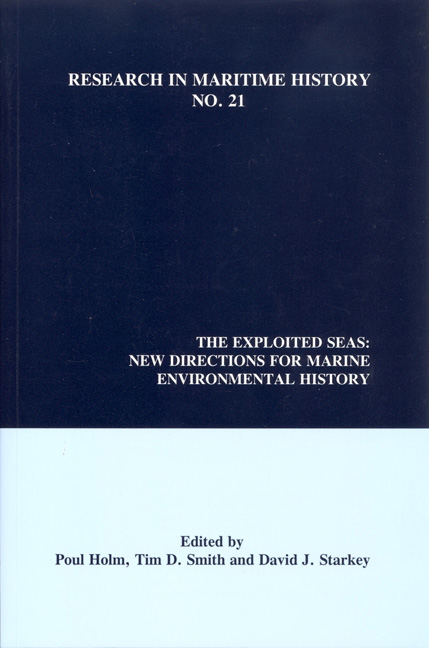Book contents
- Frontmatter
- Contents
- About the Editors
- Contributors
- “Introduction”
- Contributions
- “The Newfoundland Fisheries, c. 1500-1900: A British Perspective”
- “Testing Ecological Models: The Influence of Catch Rates on Settlement of Fishermen in Newfoundland, 1710-1833”
- “Nineteenth-Century Expansion of the Newfoundland Fishery for Atlantic Cod: An Exploration of Underlying Causes”
- “Status and Potential of Historical and Ecological Studies on Russian Fisheries in the White and Barents Seas: The Case of the Atlantic Salmon (Salmo Salar)”
- “The Danish Fisheries, c. 1450-1800: Medieval and Early Modern Sources and Their Potential for Marine Environmental History”
- “Historical Approaches to the Northern California Current Ecosystem”
- “Potential for Historical-Ecological Studies of Latin American Fisheries”
- “The South African Fisheries: A Preliminary Survey of Historical Sources”
- “The Potential for Historical Studies of Fisheries in Australia and New Zealand”
- “Examining Cetacean Ecology Using Historical Fishery Data”
“Historical Approaches to the Northern California Current Ecosystem”
from Contributions
- Frontmatter
- Contents
- About the Editors
- Contributors
- “Introduction”
- Contributions
- “The Newfoundland Fisheries, c. 1500-1900: A British Perspective”
- “Testing Ecological Models: The Influence of Catch Rates on Settlement of Fishermen in Newfoundland, 1710-1833”
- “Nineteenth-Century Expansion of the Newfoundland Fishery for Atlantic Cod: An Exploration of Underlying Causes”
- “Status and Potential of Historical and Ecological Studies on Russian Fisheries in the White and Barents Seas: The Case of the Atlantic Salmon (Salmo Salar)”
- “The Danish Fisheries, c. 1450-1800: Medieval and Early Modern Sources and Their Potential for Marine Environmental History”
- “Historical Approaches to the Northern California Current Ecosystem”
- “Potential for Historical-Ecological Studies of Latin American Fisheries”
- “The South African Fisheries: A Preliminary Survey of Historical Sources”
- “The Potential for Historical Studies of Fisheries in Australia and New Zealand”
- “Examining Cetacean Ecology Using Historical Fishery Data”
Summary
Abstract
This paper attempts to show how historical ecology, paleoclimatology and environmental history might come together to describe the structure and dynamics of the coastal marine ecosystem off the west coast of North America over the past several centuries. From this historical record we see that the stock of commercially and ecologically important species in the region has fluctuated in response to large-scale climate forcing. In addition, it appears that the twentieth century has been different from the late eighteenth and nineteenth centuries both climatically and biologically. This suggests that the ecosystem was structured very differently in previous centuries than it is now.
Far from being an esoteric concern, the development of an historic sensibility ought to be considered fundamental to conservation biology.
Introduction
The continental margin of North America off the coasts of California, Oregon Washington and southern British Columbia, the California Current Ecosystem (CCE), is a highly productive region that has long supported the commercial harvest of a variety of marine resources. This region is an ecotone, composed of a small number of endemic coastal species and a larger mixture of subarctic and subtropical species, many near the periphery of their distributional range. It is an “open” system, meaning that it is a transition environment between subarctic and subtropical water masses and the freshwater systems that enter the ocean along its landward boundary (Figure 1). The CCE constitutes one of only five global oceanic regions where the biological production is (to a significant degree) determined by wind-driven coastal upwelling. Large-scale advection of nutrient rich water from the subarctic region has been suggested as an alternative and, perhaps complementary, mechanism to explain highly significant low-frequency patterns in biological production.
The northern half of the CCE, the region of coastal ocean between Cape Mendocino (CA) and the northern tip of Vancouver Island (BC), is a Zoogeographie transition between Californian and Aleutian biological provinces. Fisheries of these regions tend to be spatially extensive and fairly uniform in species content. This region (NCCE) is thus an appropriate ecological unit for regional management and is the focus of this paper. Although we focus on the NCCE, much of the paleoscientific information that we use comes from the southern part of the CCE, primarily the region off central and southern California.
- Type
- Chapter
- Information
- The Exploited SeasNew Directions for Marine Environmental History, pp. 123 - 140Publisher: Liverpool University PressPrint publication year: 2001



